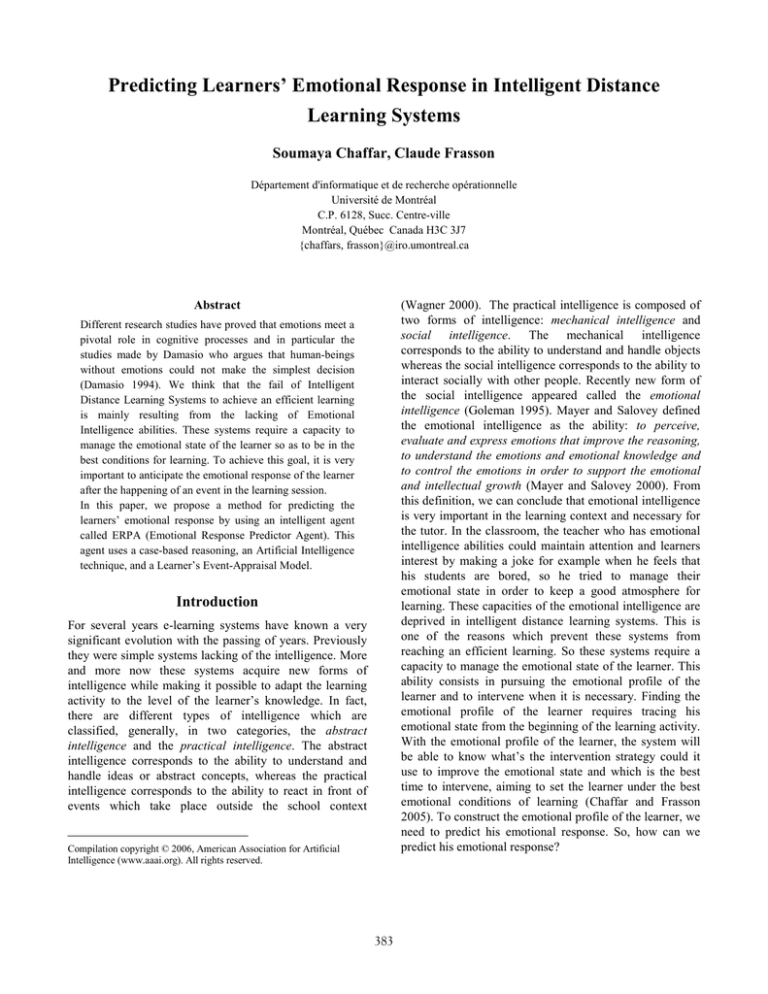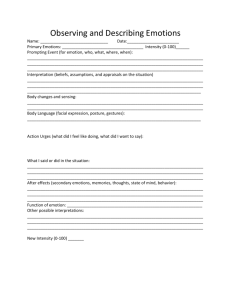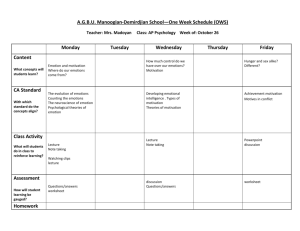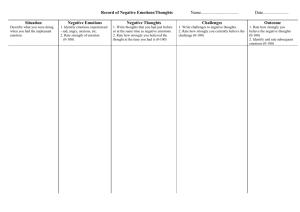
Predicting Learners’ Emotional Response in Intelligent Distance
Learning Systems
Soumaya Chaffar, Claude Frasson
Département d'informatique et de recherche opérationnelle
Université de Montréal
C.P. 6128, Succ. Centre-ville
Montréal, Québec Canada H3C 3J7
{chaffars, frasson}@iro.umontreal.ca
(Wagner 2000). The practical intelligence is composed of
two forms of intelligence: mechanical intelligence and
social intelligence. The mechanical intelligence
corresponds to the ability to understand and handle objects
whereas the social intelligence corresponds to the ability to
interact socially with other people. Recently new form of
the social intelligence appeared called the emotional
intelligence (Goleman 1995). Mayer and Salovey defined
the emotional intelligence as the ability: to perceive,
evaluate and express emotions that improve the reasoning,
to understand the emotions and emotional knowledge and
to control the emotions in order to support the emotional
and intellectual growth (Mayer and Salovey 2000). From
this definition, we can conclude that emotional intelligence
is very important in the learning context and necessary for
the tutor. In the classroom, the teacher who has emotional
intelligence abilities could maintain attention and learners
interest by making a joke for example when he feels that
his students are bored, so he tried to manage their
emotional state in order to keep a good atmosphere for
learning. These capacities of the emotional intelligence are
deprived in intelligent distance learning systems. This is
one of the reasons which prevent these systems from
reaching an efficient learning. So these systems require a
capacity to manage the emotional state of the learner. This
ability consists in pursuing the emotional profile of the
learner and to intervene when it is necessary. Finding the
emotional profile of the learner requires tracing his
emotional state from the beginning of the learning activity.
With the emotional profile of the learner, the system will
be able to know what’s the intervention strategy could it
use to improve the emotional state and which is the best
time to intervene, aiming to set the learner under the best
emotional conditions of learning (Chaffar and Frasson
2005). To construct the emotional profile of the learner, we
need to predict his emotional response. So, how can we
predict his emotional response?
Abstract
Different research studies have proved that emotions meet a
pivotal role in cognitive processes and in particular the
studies made by Damasio who argues that human-beings
without emotions could not make the simplest decision
(Damasio 1994). We think that the fail of Intelligent
Distance Learning Systems to achieve an efficient learning
is mainly resulting from the lacking of Emotional
Intelligence abilities. These systems require a capacity to
manage the emotional state of the learner so as to be in the
best conditions for learning. To achieve this goal, it is very
important to anticipate the emotional response of the learner
after the happening of an event in the learning session.
In this paper, we propose a method for predicting the
learners’ emotional response by using an intelligent agent
called ERPA (Emotional Response Predictor Agent). This
agent uses a case-based reasoning, an Artificial Intelligence
technique, and a Learner’s Event-Appraisal Model.
Introduction
For several years e-learning systems have known a very
significant evolution with the passing of years. Previously
they were simple systems lacking of the intelligence. More
and more now these systems acquire new forms of
intelligence while making it possible to adapt the learning
activity to the level of the learner’s knowledge. In fact,
there are different types of intelligence which are
classified, generally, in two categories, the abstract
intelligence and the practical intelligence. The abstract
intelligence corresponds to the ability to understand and
handle ideas or abstract concepts, whereas the practical
intelligence corresponds to the ability to react in front of
events which take place outside the school context
Compilation copyright © 2006, American Association for Artificial
Intelligence (www.aaai.org). All rights reserved.
383
develop believable agents within the OZ project. These
agents are able to express emotions after evaluating the
impact of an event on the agent’s goals (Reilly and Bates
1992). However, (Rehm and André 2005) research was
focused on synthetic agents that should express emotions
which are in conflict with their appraisal process.
Besides, in the learning context, Lester and colleagues
created a pedagogical agent called Cosmo. This agent is
able to show emotive behaviors in the purpose to support
learners in problem-solving activities (Lester, Towns, and
FitzGerald 1999). Nkambou and colleagues, in the same
context, proposed a platform for pedagogical affective
agents in which they presented two agents one is for
recognizing emotions and the other is for expressing them
(Nkambou, Héritier, and Frasson 2005). Also in a learning
context, Lisetti and colleagues have implemented a model
for the affective state of the avatar based on the Belief
Desire Intention architecture (Paleari, Lisetti, and Lethonen
2005).
In MIT media lab Picard and colleagues proposed a
model that describes the changing of the emotional state
during model-based learning experiences, to aid efficient
learning (Kort, Reilly, and Picard 2001). In the best of our
knowledge, few works have been interested in modeling
the learners’ emotional state. Thus the aim of this research
is to predict the learners’ emotional response using
computational models of emotions and the CBR technique.
Our approach is based on the event-appraisal model of
emotions, proposed by Ortony, Clore and Collins (OCC)
(Ortony, Clore, and Collins 1988), and consists in
modeling the learners’ event-appraisal process.
In this work, we present an agent called ERPA
(Emotional Response Predicting Agent). ERPA uses a
method for predicting the emotional response of the learner
using the Case-Based Reasoning (CBR) technique and a
Learner’s Event-Appraisal Model inspired by the OCC
model (Ortony, Clore, and Collins 1988).
This paper begins with a survey of previous work
realized and interested in computational models of
emotions. Next, we discuss some appraisal theories that
exist and present a Learner’s Event-Appraisal Model
inspired by the OCC model (Ortony, Clore, and Collins
1988). After that, in the section 3, we present the ERPA, an
agent for predicting the learners’ emotional response. In
the same section, we present first some basic elements of
the CBR technique, second the architecture of the ERPA
agent and third we discuss the strategy used by the ERPA.
In the section 4, we show an experiment that we have
developed to initialize the case-base for predicting the
emotional response of the learner. Finally, we conclude the
paper and present the studies that we project to do in the
future.
Previous Work
Various research studies argue that emotions play a crucial
role in decision-making, cognitive processes and
performance (Damasio 1994; Goleman 1995; Isen 2000).
According to studies made by Damasio, without emotions
human beings are not able to make the simplest decision
(Damasio 1994). Analogically some researchers consider
that the information processing systems also cannot then
make good decisions without emotions. Indeed, Sloman
thinks that intelligent machines should essentially
experience emotion (Sloman and Croucher 1987).
Moreover, Mavin Minsky confirms that “The question is
not whether intelligent machines can have emotions, but
whether machines can be intelligent without any emotions”
(Minsky 1985).
In the same perspective, some Artificial Intelligence
(AI) researchers have put an interest in computational
models of emotions and especially in the agent research
community. So, a large amount of research has been
interested in embedding computational models of emotions
in virtual agents. For instance, Seif el-Nasr and colleagues
proposed a new computational model of emotions that can
be integrated in intelligent agents. This model uses fuzzylogic to represent events and observations to emotional
states (Seif El-Nasr, Yen, and Ioerger 2000). In addition,
Gratch and Marsella proposed a model for deriving
emotion and for informing a number of the behaviors that
must be modeled by virtual humans like facial expressions,
planning, etc. (Gratch and Marsella 2004). Moreover,
Reilly and Bates used the event-appraisal model of Ortony
and colleagues (Ortony, Clore, and Collins 1988) to
The Learner’s Event-Appraisal Model
According to appraisal theorists emotions are exhibited as
a consequence of certain interpretations and events
appraisals. Appraisal, as defined by Sellers and Peterson,
“determines one’s reactions to an event, including attempts
to cope with it” (Sellers and Peterson 1993). In the purpose
to predict emotion elicitation, some theorists in psychology
have developed different event-appraisal models of
emotions. Each one has defined different number and types
of appraisal criteria and a set of emotions to cover.
Roseman’s model, for example, defines 5 criteria of event
evaluation which, according to their values, identify 13
distinct emotions (Roseman 1991). For the OCC model
Ortony, Clore and Collins (1988) have defined three
aspects which could cause emotional reactions:
consequences of events, actions of agents or aspects of
objects and they specified 22 emotion types. These
emotion types were classified according to the three
aspects. For the emotion types elicited by the consequences
of events, the authors have distinguished between
consequences for other and consequences for self. In our
384
solution associated to the case. Aamodt and Plaza in 1994
have defined the CBR as a cyclical process (see Figure 1).
work, we are focusing only on events that have
consequences for self and could modify user’s own
emotions. So we define a set of eight emotions (Joy,
Distress,
Hope,
Satisfaction,
Fears-confirmed,
Disappointment, and Relief) and for each one we
associated the rule which might cause it (see Table 1). For
example, a learner has passed an evaluation test and he is
waiting for the result, if we suppose that he has passed the
test well and he expects to have a good mark greater than
15/20 and less than 17/20. So, this situation may cause
hope as emotional response to the expected event. After
that, suppose that this learner has obtained 18/20 in the
test, this event may cause to him a satisfaction for having a
mark greater than 15, it may also cause joy because the
learner doesn’t expect to obtain a mark greater than 17.
Emotion Type
Rule
Joy
Happening of a desirable event.
Distress
Hope
Fear
Happening of an undesirable event.
Waiting a prospected desirable event.
Waiting a prospected undesirable
event.
Happening of the prospected desirable
event.
Happening
of
the
prospected
undesirable event.
Not happening of the prospected
desirable event.
Not happening of the prospected
undesirable event.
Satisfaction
Fears-confirmed
Disappointment
Relief
Figure 1. The CBR cycle (Aamodt and Plaza 1994)
As shown in the figure above, the cyclical process of the
CBR is composed of 4 steps:
•
•
•
•
Table 1. The learner's event appraisal rules
The retrieval phase: it consists in searching the
most similar cases of the case-base to the new
problem to be solved.
The reuse phase: it consists in taking the solution
of the case selected in the preceding phase, and to
adapt it for the new problem.
The revise phase: it consists in checking if the
solution suggested can solve the problem or it
requires new modifications.
The retain phase: in this phase the new solution is
retained in the case-base.
To predict the emotional response of the learner, several
things require to be taken into account and essentially the
individual differences, the initial emotional state and the
event occurred that might change this emotional state. For
this reason, the ERPA agent uses the CBR technique in
which the case description represents some individual
differences criteria (age, sex, nationality, and personality),
the initial emotional state and the event occurred. The
solution associated to the case description represents the
learner’s emotional response.
The table above shows the set of rules that might trigger
an emotion; in the next section, we explain how we use
these rules for predicting the learners’ emotional response.
The Emotional Response Predictor Agent
(ERPA)
Since the emotional response is an individual mechanism
which depends on the human experience, culture, age, etc.,
we have thought to integrate the CBR technique in the
ERPA agent, in the purpose to consider other criteria in
addition to the rules identified previously.
The ERPA Architecture
The architecture of the ERPA presented in the Figure 2 is a
three tiers architecture that consists of a User Interface
Tier, an Application Tier and a Data Base Tier.
The CBR Technique
This AI technique tries to find a solution for a problem by
searching a similar problem in the case-base, taking the
solution of the past problem and using it to find a solution
for the present problem. A case in the case-base is
considered as a past experience that has been resolved and
it is composed of two parts: the case description and the
•
385
The User Interface Tier: it represents the
interfaces by which the ERPA agent interacts
with the learner.
•
•
vector of n attributes and the solution is constituted by a
vector of m attributes as shown bellow:
The Application Tier: this component
corresponds to the strategy exploited by the agent
to forecast the emotional response of the learner.
The Data Base Tier: it represents the case-base
in which the ERPA agent stores the cases.
( att1, att2 ,..., attn ,
att1 , att 2 ,..., att m
).
The problem in the present application represents the
learner with a set of attributes defined as: nickname, age,
sex, nationality, personality, initial emotion, and event. We
have identified different classes of ages: [15-25], [25-35],
[35-45], etc. For each attribute identified previously, a
weight wi is respectively associated: 0.0, 0.1, 0.1, 0.1, 0.1,
0.3, and 0.3. So, the largest value of wi is associated to the
initial emotion and to the event occurred. These weights
are valid only for calculating the similarities between two
cases. For example if we have a problem case p1 defined
as:
Eternel ,34, male, canadian, Extravert, fear ,12
and a case p2 defined as:
Souma,28, Female, tunisian, Extravert, fear ,15
Figure 2. The ERPA architecture
The Application Tier of the ERPA agent architecture
will be explained more in detail in the next section.
S(P1, P2) = (0.0 * 0) + (0.1 *1) + (0.1 * 0) + (0.1 * 0)
+ (0.1 *1) + (0.3 *1) + (0.3 *1) = 0.8
The ERPA Strategy
The strategy used to predict the emotional response of the
learner proceeds in the Application Tier. It consists in
using the CBR technique and the learner’s event appraisal
rules that we have previously identified (see Table 1).
Suppose that the set of events that might arise during a
learning session is noted by E and each event occurred at
time i is noted by ei. We are attempting to predict ri, the
emotional response that occurred after a given event ei has
aroused. When a new problem arises to find ri, it is
transformed into target case of which the description part
of the case uses the same formalism of representation as
that used by the sources cases stored in the case-base. The
solution part of the target case is built by seeking among
the sources cases those of which the description of the case
is the most similar to the description of the target case. To
calculate this similarity, the ERPA uses the k-nearestneighbors in which the similarity between two cases c and
q is defined as:
S(c, q) = ∑ wi Si (ci , qi ) .
So, the similarity rate for the participants named Eternel
and Souma is 80 %.
The solution is represented by a unique attribute which
is the learner’s emotional response ri. An example of case
representation is given in the next section (see Figure 4).
Initializing the Case-Base
To fill the case-base with an initial set of cases, we set up
an experiment in which 52 participants have introduced the
nickname, the age, the sex, and the nationality in the aim to
build the attributes of the case problem. Next, the
participants have to answer to the Abbreviated form of the
Revised Eysenck Personality Questionnaire (EPQR-A) for
identifying their personality traits (Francis, Brown, and
Philipchalk 1992). After that, they have to pass an
evaluation test which consists in answering ten questions in
algorithm and data structure. After passing the test, we ask
them if they expect to succeed in the test or not. To affect a
value to the initial emotion attribute, we proceeds as
follow:
(1)
Where:
ci = the attributes of the case c.
qi = the attributes of the case q.
Si = the different similarities of the attributes.
wi= the weights associated to the attributes.
IF
THEN
ELSE
Expect (learner, succeed) is TRUE
initial_emotion = HOPE
initial_emotion = FEAR
We also ask the participants to enter the mark that they
expect to obtain, and then we give them the result. Next,
after having obtained the mark, they have to choose the
emotions that they feel following the occurrence of this
event (see Figure 3) from a set of 6 emotions (Joy,
The cases, in the case-base used by the ERPA are
represented as a couple of problem and solution. The
problem in the case-base is represented in the form of a
386
Distress, Satisfaction,
Disappointment).
Fear-confirmed,
Relief,
his reasoning and performance. For this reason, this
research is focused on the learners’ affective state.
This research work is interested in predicting the
learners’ emotional response in Intelligent Distance
Learning Systems. To this end, we have proposed a
method in which we used the CBR technique and some
learners’ event-appraisal rules that we have identified
basing on the OCC model (Ortony, Clore, and Collins
1988). After predicting the learner’s emotional response,
the system will require a strategy by which it could change
his emotional state like the one used in (Chaffar and
Frasson 2004). So, in the next step we will concentrate on
the intervention strategies to choose the best one depending
on individual differences.
Moreover, in this work we are limited, for the moment,
in a set of 8 emotions (Joy, Distress, Hope, Fear,
Satisfaction, Fear-confirmed, Relief, and Disappointment).
For the future, we plan to cover more other emotions
which are related, in the OCC model, to the actions of
Agents. The set of agents will be the tutor and other
learners in a collaborative learning system. So we will
attempt to model the learner’s emotional response after an
action made by one of these agents (tutor and other
learners). For future studies we will concentrate also on
modeling the emotional reaction of the tutor following an
action from the learner.
and
Learners' emotional responses
8
participants numbers
7
Joy
6
Distress
5
Satisfaction
4
Fear-confirmed
3
Relief
2
Disappointment
1
0
Hope
Fear
Learners initial em otions
Figure 3. Learners' emotional responses
With all the attributes mentioned previously (nickname,
age, sex, nationality, personality, initial emotion, and
event), we construct the case (see Figure 4) and we store it
in the case-base.
Acknowledgements
We acknowledge the support for this work from
Valorisation Recherche Québec (VRQ). This research is
part of the DIVA project: 2200-106. We also acknowledge
the support for this work from the Fond Québecois pour la
Recherche sur la Société et la Culture (FQRSC).
Figure 4. Example of a case in the case-base
This tree shows an example of case that we have
obtained from the experiment. It demonstrates a participant
named Eternel, his age is 34, he is a Canadian and has an
extravert personality which is found by applying the
EPQR-A questionnaire (Francis, Brown, and Philipchalk
1992). After passing the evaluation test, he expects that
he wouldn’t succeed to the test, but fortunately he obtains
12/20 and succeeds. So he feels relieved.
All these cases will be useful, as a starting point, to
predict the learners’ emotional responses, by calculating
the similarity between two cases with equation (1). So, the
predicted emotion will be the solution of the most similar
case.
References
Aamodt, A., and Plaza, E. 1994. Case-Based Reasoning:
Foundational Issues, Methodological Variations, and
System Approaches. AI Communications 7:39-59.
Chaffar, S., and Frasson, C. 2005. The Emotional
Conditions of Learning. In Proceedings of the 18th
International FLAIRS Conference. Clearwater, FL, USA:
AAAI Press.
Chaffar, S., and Frasson, C. 2004. Inducing Optimal
Emotional State in Intelligent Tutoring System. In
Proceedings of International Conference of Intelligent
Tutoring System (ITS). Maceio, Brazil: Springer verlag.
Conclusion and Future Research
Since emotions are widely related to cognitive processes,
Intelligent Distance Learning Systems should consider
these affective states. They play a fundamental role in
maintaining the attention of the learner and in improving
Damasio, A. 1994. Descartes Error – Emotion, Reason
and the Human Brain. New York: Putnam Press.
Francis, L., Brown, L., and Philipchalk, R. 1992. The
development of an Abbreviated form of the Revised
387
Eysenck Personality Questionnaire (EPQR-A). Personality
and Individual Differences 13: 443-449.
Seif El-Nasr, M., Yen, J., and Ioerger, T. 2000. FLAME A Fuzzy Logic Adaptive Model of Emotions. Automous
Agents and Multi-agent Systems 3: 219-257.
Goleman, D. eds. 1995. Emotional Intelligence. New York:
Bantam Books.
Sellers, R.M., and Peterson, C. 1993. Explanatory Style
and Coping with Controllable Events by Students-Athletes.
Cognition and Emotion 7: 431-441.
Gratch, J. Marsella, S. A Domain-independent Framework
for Modelling emotion. Journal of Cognitive Systems
Research. 5: 4.
Sloman, A. Croucher, M. 1987. Why Robots will have
emotions. In Proceeding of IJCAI-87, 197-202.
Isen, A. M. 2000. Positive Affect and Decision Making.
Handbook of Emotions.
Wagner, R.K. 2000. Practical Intelligence. Handbook of
Intelligence. Cambridge: Cambridge University Press.
Kort, B., Reilly, R., and Picard, R. 2001. An Affective
Model of Interplay Between Emotions and Learning:
Reengineering Educational Pedagogy—Building a
Learning Companion. In Proceedings of ICALT 2001
Madison Wisconsin.
Lester, J. C., Towns, S. G., & FitzGerald, P. J. (1999).
Achieving
Affective
Impact:
Visual
Emotive
Communication in Lifelike Pedagogical Agents. The
International Journal of Artificial Intelligence in
Education, 10:278-291.
Minsky, M. L. 1985. The Society of Mind. Simon &
Shuster, Old Tappan, NJ.
Mayer J.D., Salovey P., and Caruso D.R. 2000. Models of
emotional intelligence. In R. J. Sternberg (Ed.). Handbook
of Human Intelligence 2:396-420. New York: Cambridge.
Nkambou, R., Héritier, V., and Frasson, C. Plate-forme
pour agents pédagogiques affectives: expression et
reconnaissance des émotions. Innovations et tendances en
technologies de formation et d'apprentissage. In Samuel
Pierre (Eds), Montréal, Canada : Polytechnic International
Press.
Ortony A., Clore G.L, and Collins A. 1988. The cognitive
Structure of Emotions. Cambridge: Cambridge University
Press.
Paleari, M., Lisetti, C., and Lethonen, M. 2005. VALERIE:
Virtual Agent for Learning Environment Reacting and
Interacting Emotionally. In Proceedings of the 12th
International Conference on Artificial Intelligence in
Education (AIED), Amsterdam, Netherlands.
Rehm, M. André, E. 2005. Catch Me If You Can -Exploring Lying Agents in Social Settings. In Proceedings
of the International Conerence on Autonomous Agents and
Multiagent Systems. Utrecht, Netherlands.
Reilly, W. S. and Bates, J. 1992. Building emotional
agents. Technical Report, CMU-CS-92-143, Carnegie
Mellon University.
Roseman, I.J. 1991. Appraisal determinants of discrete
emotions. Cognition and Emotion 3 : 161-200.
388




